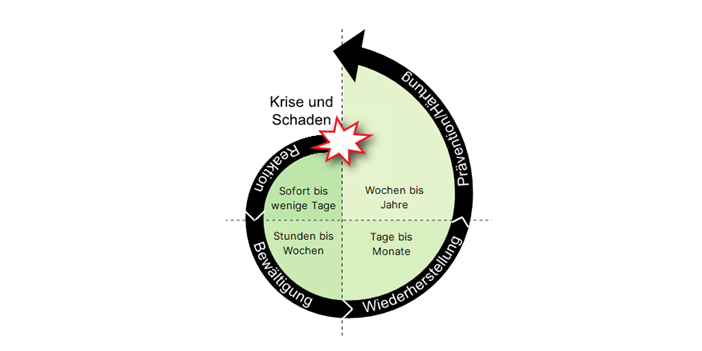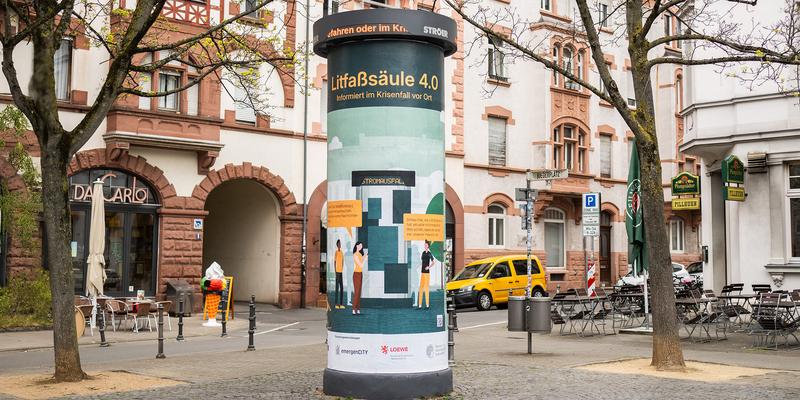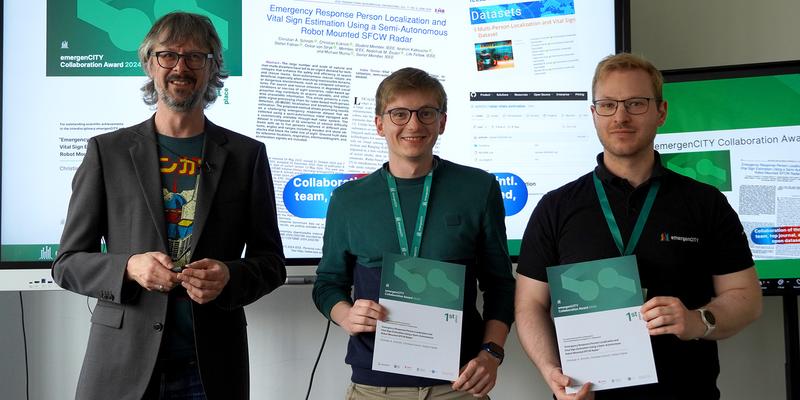The devastating floods in mid-July 2021 painfully demonstrated the vulnerability of our cities. The extent of the devastation, caused by heavy rain, shook the whole of Germany. In parallel with the reconstruction, the important question of future disaster control is now also being raised in the follow-up. What can we do to be better prepared in the future? It is the task of science to learn from a disaster, to share the findings with communities and the population and to support improvements here.
In the context of research on urban resilience, some emergenCITY research projects deal with the topic of floods. In the following, we would like to present these projects and show how emergenCITY’s research beforehand and in all phases of crises can contribute to mitigate future flood disasters and protect population and critical infrastructure – and furthermore how communication and rescue operations can be supported by emergenCITY technologies in case of an emergency.

Early warning system for flash floods
In Santiago de Chile, emergenCITY scientist Benjamin Becker is conducting research together with Professor Christian Oberli of the Pontificia Universidad Católica de Chile on a wireless early warning system for flash floods. The early warning system consists of a series of monitoring stations connected in a Wireless Sensor Network that measures data such as temperature, rainfall, humidity, and barometric pressure. If this data indicates a flash flood danger, the measuring stations send a warning and enable the population to evacuate from endangered areas in time. The network of measuring stations is able to exchange information wirelessly among each other and send the warnings from measuring station to measuring station quickly, reliably and energy-efficiently to the valley using a new developed communication protocol.
Resilience for neighborhoods and app “Lokalfunk”
Neighborly help plays an important role in coping with major crisis events: people organize themselves in their neighborhoods and help each other. While this was still a purely analog process in the past, messenger apps are now also used to support self-organization. Unfortunately, however, the apps are not designed to work without internet connection and quickly fail when the communication infrastructure is damaged, for example, when servers or transmission towers are damaged. For this case, emergenCITY is working on a resilience concept that is based on interdisciplinary compiled requirements and enables citizens to communicate resiliently in everyday life as well as during crisis events. We are developing the neighborhood app “Lokalfunk”, which supports self-organization in everyday life and which continues to function independently of the internet even in crisis situations.
Use of drones and rescue robots
emergenCITY professor Oskar von Stryk and his team are conducting research in cooperation with the German Rescue Robotics Center (DRZ) on the development and improvement of drones and robots for use in crisis and disaster situations. The rescue robots can take over tasks in danger zones that rescue workers cannot enter, for example in buildings that are in danger of collapsing or in a damaged chemical laboratory. Here, equipped with various tools, measuring systems and cameras, the robots can perform exploration work and provide an accurate picture of the situation or move various objects. Camera, infrared camera and radar can also be used to find missing persons. During the flood disaster in July 2021, the DRZ rescue robot Telemax was already requested by the state of NRW and emergenCITY scientist Marius Schnaubelt was on site with the robot. Once there, however, there was no more task for the robot and it was not used here.
Surveys in the Ahr valley
The emergenCITY scientists Anna Stöckl and Steffen Haesler and an interdisciplinary team of emergenCITY researchers are dealing specifically with the course of the crisis in the Ahr Valley. With an online survey, they ask those affected by the flood disaster about their experiences. From the results, as well as through additional interviews with full-time, volunteer and spontaneous helpers, they investigate how the unavailability of critical infrastructure is perceived in different phases of the crisis. Of particular interest are drinking water supply, wastewater disposal, electricity supply, mobile phone and transport networks.
Learning from past crises
Lessons from past flood crises are again being collected by emergenCITY researcher Nadja Thiessen. As part of her PhD, she is researching the coping strategies of the cities of Mannheim and Dresden in the face of threats to urban infrastructures from flooding. In her work, she analyzes the years 1918 to 1989, so we can learn from 70 years of dealing with flood crises here. The results are expected to be published in 2022.
Research on water-intensive urban design.
emergenCITY professor Annette Rudolph-Cleff from the Department of Architecture is an expert in water-intensive urban design. In this, the goal is to incorporate opportunities for flood protection, water resource management, and urban climate resilience into urban planning processes. Prof. Rudolph-Cleff’s research focuses on water-specific urban resilience concepts, such as flood protection of urban infrastructures in Rotterdam, and at the same time on the value of water in urban design, for example in greening or even cooling cities.



